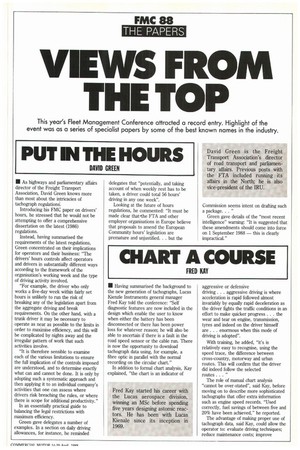IE
Page 39

If you've noticed an error in this article please click here to report it so we can fix it.
WS FROM THE TOP
This year's Fleet Management Conference attracted a record entry. Highlight of the event was as a series of specialist papers by some of the best known names in the industry.
PUT IN THE HOURS
DAVID GREEN • As highways and parliamentary affairs director of the Freight Transport Association, David Green knows more than most about the intricacies of tachograph regulation.
Introducing his FMC paper on drivers' hours, he stressed that he would not be attempting to offer a comprehensive dissertation on the latest (1986) regulations.
Instead, having summarised the requirements of the latest regulations, Green concentrated on their implications for operators and their business: "The drivers' hours controls affect operators and drivers in substantially different ways according to the framework of the organisation's working week and the type of driving activity involved.
"For example, the driver who only works a five-day week within fairly set hours is unlikely to run the risk of breaking any of the legislation apart from the aggregate driving and break requirements. On the other hand, with a trunk driver it may be necessary to operate as near as possible to the limits in order to maximise efficiency, and this will be complicated by nights away and the irregular pattern of work that such activities involve.
"It is therefore sensible to examine each of the various limitations to ensure the full implication of the controls imposed are understood, and to determine exactly what can and cannot be done. It is only by adopting such a systematic approach and then applying it to an individual company's activities that one can assess where drivers risk breaching the rules, or where there is scope for additional productivity."
In an essentially practical guide to balancing the legal restrictions with maximum efficiency.
Green gave delegates a number of examples. In a section on daily driving allowances, for instance, he reminded delegates that "potentially, and taking account of when weekly rest has to be taken, a driver could total 56 hours' driving in any one week".
Looking at the future of hours regulations, he commented: "It must be made clear that-the FTA and other employer organisations in Europe believe that proposals to amend the European Community hours' legislation are premature and unjustified. . but the Commission seems intent on drafting such a package.
Green gave details of the "most recent intelligence" warning: "It is suggested that these amendments should come into force on 1 September 1988 — this is clearly impractical."












































































































